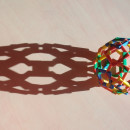3d printing of next revolution multi-material fabricated parts
3d printing of multi-material parts could be the next printing revolution.
For a long time, 3d printing was limited to printing from a single material in a single colour. This was great for printing prototypes but for mechanical parts, there was often some manual assembly required after printing. However, 3d printing of multimaterial fabricated parts is set to revolutionise the industry thanks to continuing development in printing technology.
3d printing in multi colour
Last year several companies unveiled their lates printers which are capable of priniting in a variety of colours using a traditional combination of cyan, magenta and Yellow filaments, the result is a completely full-colour option for the first time.
Multi-material 3d printing
More impressively, The development of multimaterial fabricated parts has changed the appeal of 3d printing overnight.
Until now, large scale manufacturers have struggled to make the most of 3d printing due to printing limitations and the slow production speed. Combinations of rigid, flexible and transparent materials can combined in a single print as well as moving parts. This has removed the need for assembly and painting which can speed up the manufacturing process and save on costs.
Production of multi-material fabricated parts is sure to signal the next revolution in 3d printing and could encourage large manufacturing companies to join the 3d printing movement. Similarly, 3d printing enthusiasts will no doubt be tempted to make the most of the new technologies for home projects or just for fun.













